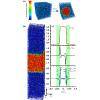当前位置:
X-MOL 学术
›
Phys. Rev. E
›
论文详情
Our official English website, www.x-mol.net, welcomes your
feedback! (Note: you will need to create a separate account there.)
Microscopic origins of the swim pressure and the anomalous surface tension of active matter.
Physical Review E ( IF 2.2 ) Pub Date : 2020-01-01 , DOI: 10.1103/physreve.101.012604 Ahmad K Omar 1 , Zhen-Gang Wang 1 , John F Brady 1
Physical Review E ( IF 2.2 ) Pub Date : 2020-01-01 , DOI: 10.1103/physreve.101.012604 Ahmad K Omar 1 , Zhen-Gang Wang 1 , John F Brady 1
Affiliation

|
The unique pressure exerted by active particles-the "swim" pressure-has proven to be a useful quantity in explaining many of the seemingly confounding behaviors of active particles. However, its use has also resulted in some puzzling findings including an extremely negative surface tension between phase separated active particles. Here, we demonstrate that this contradiction stems from the fact that the swim pressure is not a true pressure. At a boundary or interface, the reduction in particle swimming generates a net active force density-an entirely self-generated body force. The pressure at the boundary, which was previously identified as the swim pressure, is in fact an elevated (relative to the bulk) value of the traditional particle pressure that is generated by this interfacial force density. Recognizing this unique mechanism for stress generation allows us to define a much more physically plausible surface tension. We clarify the utility of the swim pressure as an "equivalent pressure" (analogous to those defined from electrostatic and gravitational body forces) and the conditions in which this concept can be appropriately applied.
中文翻译:

游泳压力和活性物质异常表面张力的微观起源。
活性颗粒施加的独特压力-“游动”压力-已被证明在解释活性颗粒的许多看似混杂的行为时是有用的。然而,它的使用也导致一些令人费解的发现,包括相分离的活性颗粒之间的极负的表面张力。在这里,我们证明了这种矛盾源于游泳压力不是真正的压力这一事实。在边界或界面处,颗粒游动的减少会产生净作用力密度-完全是自体产生的体力。实际上,边界处的压力(先前被确定为游动压力)实际上是由该界面力密度产生的传统粒子压力的升高值(相对于体积)。认识到这种独特的产生应力的机制,使我们能够定义在物理上似乎更合理的表面张力。我们阐明了游泳压力作为“等效压力”(类似于由静电和重力体力所定义的压力)的实用性以及可以适当应用该概念的条件。
更新日期:2020-01-17
中文翻译:

游泳压力和活性物质异常表面张力的微观起源。
活性颗粒施加的独特压力-“游动”压力-已被证明在解释活性颗粒的许多看似混杂的行为时是有用的。然而,它的使用也导致一些令人费解的发现,包括相分离的活性颗粒之间的极负的表面张力。在这里,我们证明了这种矛盾源于游泳压力不是真正的压力这一事实。在边界或界面处,颗粒游动的减少会产生净作用力密度-完全是自体产生的体力。实际上,边界处的压力(先前被确定为游动压力)实际上是由该界面力密度产生的传统粒子压力的升高值(相对于体积)。认识到这种独特的产生应力的机制,使我们能够定义在物理上似乎更合理的表面张力。我们阐明了游泳压力作为“等效压力”(类似于由静电和重力体力所定义的压力)的实用性以及可以适当应用该概念的条件。











































 京公网安备 11010802027423号
京公网安备 11010802027423号